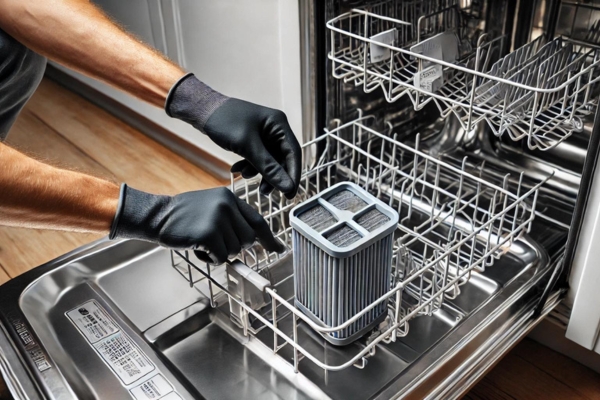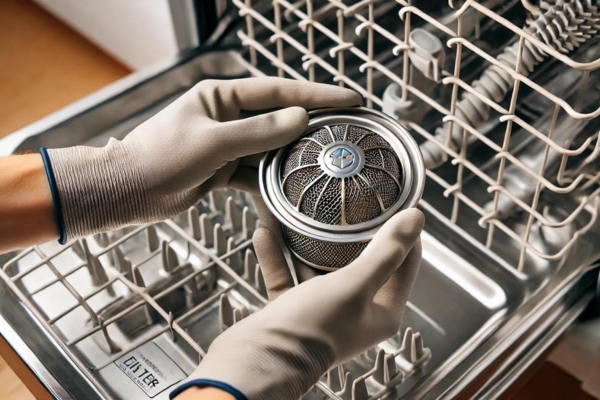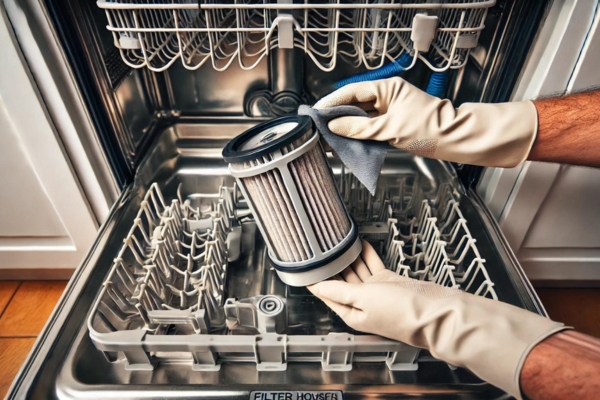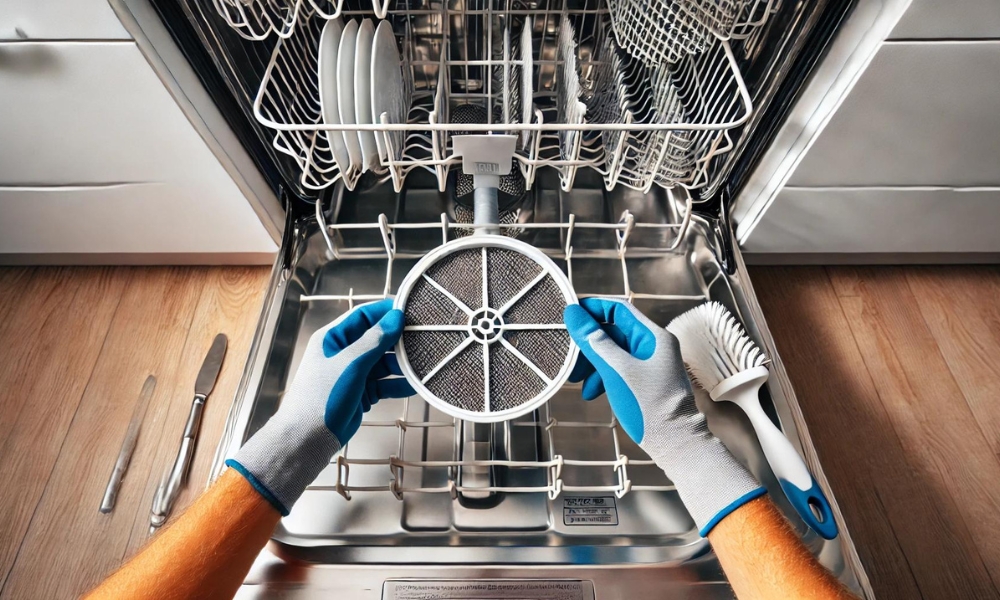Dishwashers are the unsung heroes of the modern kitchen. Day in and day out, they tackle the piles of dishes that accumulate, leaving you with spotless results. But behind that gleaming cleanliness lies a vital component: the dishwashers filter. It’s easy to forget, but like any machine, dishwashers need regular upkeep to function optimally. One of the most crucial yet often overlooked parts of dishwashers maintenance is changing the filter. This guide will walk you through why and how to change your dishwasher filter, ensuring your appliance runs like new.
What Is A Dishwasher Filter?
A dishwasher filters serves as the gatekeeper between your dirty dishes and the mechanics of the machine. Its primary job is to catch food particles, grease, and other debris, preventing them from clogging the machine’s drain or damaging internal components. Depending on your dishwashers model, you’ll either have a self-cleaning or a manual strainer. Manual filters require periodic cleaning to keep them functioning correctly, while self-cleaning models use a grinder to pulverize debris, which is then flushed out through the drain.
Why Changing Your Dishwasher Filter Matters
Dishwasher filters do an incredible job of trapping the dirt and grime that you wouldn’t want recirculating on your dishes. Over time, however, these particles accumulate, and if left unchecked, they can lead to clogging. This not only affects your dishwashers performance but can also lead to unpleasant odors, bacteria buildup, and, ultimately, dirty dishes. Regularly changing or cleaning your filter ensures that your machine operates at its peak and prolongs its lifespan.
The Importance Of A Clean Dishwasher
A clean dishwasher isn’t just about spotless dishes. It’s about hygiene, efficiency, and maintaining the appliance’s overall health. When filters become clogged, water can’t drain properly, leading to stagnant pools inside the machine. This stagnant water becomes a breeding ground for bacteria and mold, which can make their way onto your dishes. Moreover, a clogged filter forces the machine to work harder, consuming more energy and taking longer to finish cycles. Simply put, keeping your dishwashers strainer clean is essential for both cleanliness and energy efficiency.
Understanding Your Dishwasher Filters
To fully appreciate the importance of changing your filter, it’s essential to understand its role within the dishwasher. Filters trap food scraps and debris that could otherwise recirculate or block the drainage system. Most modern dishwashers are equipped with either a self-cleaning strainer, which grinds food waste, or a manual strainer, which requires periodic maintenance. While self-cleaning filters offer convenience, they can be noisier and less efficient over time if not maintained. On the other hand, manual filters require a hands-on approach but ensure a quieter, more efficient machine.
Tools You’ll Need To Change A Dishwasher Filters

Fortunately, changing a dishwasher’s filter doesn’t require a toolbox full of specialized equipment. You’ll need just a few simple items to get started:
- A pair of rubber gloves for hygiene and protection
- A soft-bristle brush or an old toothbrush for scrubbing the strainer
- Warm, soapy water for cleaning
- A towel to dry the strainer and surrounding areas Having these items on hand before starting the process ensures that the task will be quick and efficient.
Step-By-Step Guide To Changing Your Dishwasher Filter
Step 1: Removing The Bottom Rack

First, pull out the bottom rack of your dishwasher to give you easy access to the filter. Most dishwashers filters are located at the bottom, directly below the spray arm. Ensure that you have enough space to reach the strainer comfortably.
Step 2: Unlocking The Dishwasher Filters

Next, locate the filter, which will typically have a round, mesh-like appearance. Depending on the model, you may need to twist the strainer counterclockwise to unlock it. Be gentle but firm to avoid damaging the locking mechanism.
Step 3: Removing The Old Filter

Once unlocked, carefully lift the strainer out of its housing. Take a moment to inspect it for any damage or excessive buildup of debris. If the filters appears damaged, it may be time to replace it entirely.
Step 4: Cleaning The Filter Housing

Before installing the new or cleaned, check the housing where thestrainer sits. Use a cloth to wipe away any food particles or grime that might have accumulated. Keeping this area clean ensures that your dishwashers run smoothly without blockages.
How To Clean The Old Dishwasher Filter
If you’re reusing the filter, cleaning it properly is essential. Start by rinsing the filters under warm running water to dislodge loose debris. Next, soak it in warm, soapy water for about 10 minutes. Use a soft-bristle brush to scrub away any stubborn grime or grease. Once thoroughly cleaned, rinse the strainer again and let it air dry before reinstalling.
Tips To Maintain Your Dishwasher Filter
Routine maintenance is the key to a long-lasting filters. Make it a habit to clean the filter at least once a month, especially if your dishwasher handles a lot of heavy-duty loads. Avoid overloading the dishwashers, as this can strain the strainer and increase the chances of food particles clogging it. Additionally, scrape off excess food from plates before loading them into the machine to minimize debris buildup.
Common Mistakes To Avoid When Changing Your Dishwasher Filter
One of the most common mistakes when changing a dishwasher’s filter is neglecting to secure it properly. A loose strainer can cause poor drainage or allow debris to bypass the filter, leading to bigger problems. Another common error is using harsh chemicals to clean the strainer, which can cause damage. Stick to mild soap and water to preserve the integrity of the strainer.
How To Change Dishwasher Filter In Different Brands
Dishwashers filters can vary slightly depending on the brand. For instance, Whirlpool and Bosch models may have different locking mechanisms or require a slightly different cleaning process. Always refer to your manufacturer’s guide for specific instructions. However, the general principles of strainer care remain the same across most brands.
When To Call A Professional For Help
If you notice persistent problems even after cleaning or changing the strainer, such as poor drainage or water leaks, it might be time to call in a professional. Some issues may stem from deeper mechanical problems that require expert attention. It’s better to address these problems early to prevent more significant repairs down the line.
Eco-Friendly Disposal Of Old Filters

Filters made from plastic and metal components should be disposed of responsibly. Check with your local recycling center to see if they accept old dishwashers filters. In many cases, filters can be recycled, minimizing their environmental impact.
Closing Thoughts On Dishwasher Filter Maintenance
Regularly changing and maintaining your dishwasher strainer is a simple yet effective way to ensure your dishwashers remain in top condition. This routine task can prevent costly repairs, improve cleaning efficiency, and extend the lifespan of your appliance.
Why A Clean Dishwasher Filter Improves Performance
A clean filter directly impacts the overall performance of your dishwasher. It ensures that water flows freely through the machine, allowing the spray arms to distribute water evenly and efficiently. This means cleaner dishes and a more energy-efficient cycle.
How A Clean Filter Boosts Cleaning Efficiency
When the strainer is clean, there’s no risk of food particles being redeposited onto your dishes. This allows the detergent and water to work more effectively, resulting in sparkling clean dishes with every cycle.
Energy Efficiency Benefits Of Regular Filter Maintenance
Maintaining a clean filter not only improves cleaning performance but also reduces energy consumption. A clogged strainer forces the dishwasher to work harder and use more water, increasing both energy and utility costs. By keeping the strainer clean, you ensure that your machine runs smoothly and efficiently.
Conclusion
Changing your dishwasher filter may seem like a small task, but it’s one that has a big impact on the performance and longevity of your appliance. With regular care and attention, you can ensure your dishwashers continue to deliver spotless results while minimizing energy use. So, the next time you notice a decline in your dishwasher’s performance, don’t forget to check the strainer—it could be the simple solution you need.
